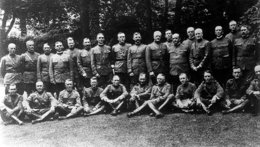American Expeditionary Force
|
|
The American Expeditionary Forces or AEF was the United States military force in World War I. The AEF helped the French defend the Western Front during the Aisne Offensive in May.
US President Woodrow Wilson initially planned to give command of the AEF to General Frederick Funston, but after Funston's sudden death, Wilson appointed General John Joseph "Black Jack" Pershing in May 1917, who oversaw US forces throughout the war. Pershing insisted that American soldiers be trained before going to Europe. As a result, few troops would arrive before 1918. In addition, Pershing insisted that the American force would not be used merely to fill gaps in the French and British armies. This attitude was resented by the Allied leaders who were short on troops.
By May 1918, there were more than 500,000 US soldiers in France and by July of the same year, there were over a million US soldiers in France. Since even the transport ships needed to bring American troops to Europe were scarce, the army pressed into service cruise ships, seized German ships, and borrowed Allied ships to transport American soldiers from New York, New Jersey, and Virginia. The mobilization effort taxed the limits of the American military and required new organizational strategies and command structures to transport great numbers of troops and supplies quickly and efficiently.
Although the first American troops, who were called "doughboys" by other allied troops, arrived in Europe in June 1917, the AEF did not fully participate at the front until October, when the 1st Division, one of the best-trained divisions of the AEF, entered the trenches at Nancy, France. Pershing wanted an American force that could operate independently of the other Allies, but his vision could not be realized until adequately trained troops with sufficient supplies reached Europe. Training schools in America sent their best men to the front, and Pershing also established facilities in France to train new arrivals for combat.
Throughout 1917 and into 1918, American divisions were usually employed to augment French and British units in defending their lines and in staging attacks on German positions. Beginning in May 1918, with the first United States victory at Cantigny, AEF commanders increasingly assumed sole control of American forces in combat. By July 1918, French forces often were assigned to support AEF operations. During the Battle of Saint-Mihiel, beginning September 12, 1918, Pershing commanded the American First Army, comprising seven divisions and more than 500,000 men, in the largest offensive operation ever undertaken by United States armed forces. This successful offensive was followed by the Meuse-Argonne offensive, lasting from September 27 to October 6, 1918, during which Pershing commanded more than one million American and French soldiers. In these two military operations, Allied forces recovered more than two hundred square miles (520 km²) of French territory from the German army.
By the time Germany signed the Armistice on November 11, 1918, the American Expeditionary Forces had evolved into a modern, combat-tested army recognized as one of the best in the world. The United States had sustained an estimated 360,000 casualties in the First World War, including 126,000 killed in action and 234,000 wounded. In less than two years the United States had established new motorized and combat forces, equipped them with all types of ordnance including machine guns and tanks, and created an entirely new support organization capable of moving supplies thousands of miles in a timely manner. World War I provided the United States with valuable strategic lessons and an officer corps that would become the nucleus for mobilizing and commanding sixteen million American military personnel in World War II.

